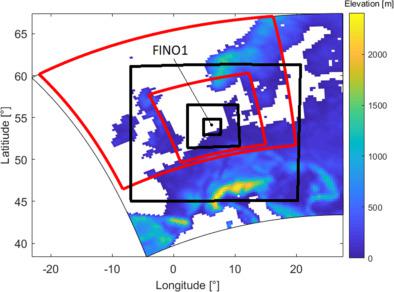当前位置:
X-MOL 学术
›
Q. J. R. Meteorol. Soc.
›
论文详情
Our official English website, www.x-mol.net, welcomes your feedback! (Note: you will need to create a separate account there.)
Evaluation of a roughness length parametrization accounting for wind–wave alignment in a coupled atmosphere–wave model
Quarterly Journal of the Royal Meteorological Society ( IF 8.9 ) Pub Date : 2020-11-21 , DOI: 10.1002/qj.3948 S. Porchetta 1, 2 , O. Temel 3 , J.C. Warner 4 , D. Muñoz‐Esparza 5 , J. Monbaliu 6 , J. Beeck 2 , N. Lipzig 1
Quarterly Journal of the Royal Meteorological Society ( IF 8.9 ) Pub Date : 2020-11-21 , DOI: 10.1002/qj.3948 S. Porchetta 1, 2 , O. Temel 3 , J.C. Warner 4 , D. Muñoz‐Esparza 5 , J. Monbaliu 6 , J. Beeck 2 , N. Lipzig 1
Affiliation

|
The importance of wind energy as an alternative energy source has increased over the latest years with more focus on offshore winds. A good estimation of the offshore winds is thus of major importance for this industry. Up to now the effect of the wind–wave (mis)alignment has not yet been taken into account in coupled atmosphere–wave models to study the vertical wind profile and power production estimations of offshore wind farms. In this study the roughness length parametrization of Drennan et al. in 2003, and its extension addressing the wind–wave (mis)alignment proposed by Porchetta et al. in 2019, are investigated in the Coupled Ocean–Atmosphere–Wave–Sediment Transport (COAWST) model. This study shows that the yearly mean wind estimation at hub height (100 m) is improved by the roughness length parametrization of Porchetta et al. compared to Drennan. This is mainly due to the increased roughness of the former parametrization compare to the latter, even in aligned wind–wave conditions. This difference in roughness is caused by the dataset used to obtain the constants, deep‐water conditions versus mixed offshore conditions. Moreover, the roughness length parametrization of Porchetta et al. performs better in two of three alignment categories. Furthermore, similar model performances are obtained if we exclude the wind directions from the wind shadow zone of the measurement mast or the wind directions from the recently built Alpha Ventus wind farm, which is in close vicinity of the measurement mast. Investigating different wind conditions shows that the new roughness length parametrization of Porchetta et al. performs best for both offshore and onshore winds. Additionally, we show that the coupled model estimations of the vertical wind are only slightly affected by significant wave height estimations. Similar model performances for different accuracies of significant wave height estimations are presented. One exception is the perpendicular alignment category where the new roughness length of Porchetta et al. outperforms the roughness length of Drennan when investigating the wind estimations related to significant wave heights with a higher accuracy. The roughness length parametrization of Porchetta et al. reduced the power production overestimation of the coupled model from 5.7 to 2.8%. We also show that the standalone atmospheric model including the roughness length of Charnock in 1955 has a degraded performance compared to the coupled model including the roughness length parametrization of Porchetta et al. for yearly average wind profiles.
中文翻译:

大气波耦合模型中考虑风波对准的粗糙度长度参数化的评估
近年来,风能作为替代能源的重要性日益提高,并且更多地关注海上风能。因此,对海上风电的良好估算对于该行业至关重要。到目前为止,在研究海浪风场的垂直风廓线和发电量估计的大气-海浪耦合模型中,尚未考虑风浪(不正确)对准的影响。在这项研究中,Drennan等人的粗糙度长度参数化。在2003年,它的扩展解决了Porchetta等人提出的风浪(误)对准问题。。在2019年,对海洋-大气-波浪-沉积物耦合(COAWST)模型进行了研究。这项研究表明,Porchetta等人的粗糙度长度参数化提高了轮毂高度(100 m)的年平均风估计。与德伦南相比。这主要是由于即使在对准的风浪条件下,与前者相比,前者参数化的粗糙度也会增加。粗糙度的这种差异是由用于获取常数的数据集(深水条件与混合海洋条件)引起的。此外,Porchetta等人的粗糙度长度参数化。在三个对齐类别中的两个类别中表现更好。此外,如果我们将测量桅杆的风影区的风向或最近建造的Alpha Ventus风电场(测量桅杆附近)的风向排除在外,则可以获得类似的模型性能。研究不同的风况表明,Porchetta等人的新的粗糙度长度参数化。对于海上和陆上风能都表现最佳。此外,我们表明,垂直风的耦合模型估计仅受到显着的波高估计的轻微影响。提出了针对不同准确度的有效波高估计的相似模型性能。一个例外是垂直对齐类别,其中Porchetta等人的新粗糙度长度。在以较高的精度调查与重要波高有关的风速估算值时,其性能优于Drennan的粗糙度长度。Porchetta等人的粗糙度长度参数化。将耦合模型的发电量高估率从5.7降低到2.8%。我们还表明,与包括Porchetta等人的粗糙度长度参数化的耦合模型相比,包括1955年Charnock粗糙度长度的独立大气模型的性能有所下降。每年的平均风廓线。
更新日期:2020-11-21
中文翻译:

大气波耦合模型中考虑风波对准的粗糙度长度参数化的评估
近年来,风能作为替代能源的重要性日益提高,并且更多地关注海上风能。因此,对海上风电的良好估算对于该行业至关重要。到目前为止,在研究海浪风场的垂直风廓线和发电量估计的大气-海浪耦合模型中,尚未考虑风浪(不正确)对准的影响。在这项研究中,Drennan等人的粗糙度长度参数化。在2003年,它的扩展解决了Porchetta等人提出的风浪(误)对准问题。。在2019年,对海洋-大气-波浪-沉积物耦合(COAWST)模型进行了研究。这项研究表明,Porchetta等人的粗糙度长度参数化提高了轮毂高度(100 m)的年平均风估计。与德伦南相比。这主要是由于即使在对准的风浪条件下,与前者相比,前者参数化的粗糙度也会增加。粗糙度的这种差异是由用于获取常数的数据集(深水条件与混合海洋条件)引起的。此外,Porchetta等人的粗糙度长度参数化。在三个对齐类别中的两个类别中表现更好。此外,如果我们将测量桅杆的风影区的风向或最近建造的Alpha Ventus风电场(测量桅杆附近)的风向排除在外,则可以获得类似的模型性能。研究不同的风况表明,Porchetta等人的新的粗糙度长度参数化。对于海上和陆上风能都表现最佳。此外,我们表明,垂直风的耦合模型估计仅受到显着的波高估计的轻微影响。提出了针对不同准确度的有效波高估计的相似模型性能。一个例外是垂直对齐类别,其中Porchetta等人的新粗糙度长度。在以较高的精度调查与重要波高有关的风速估算值时,其性能优于Drennan的粗糙度长度。Porchetta等人的粗糙度长度参数化。将耦合模型的发电量高估率从5.7降低到2.8%。我们还表明,与包括Porchetta等人的粗糙度长度参数化的耦合模型相比,包括1955年Charnock粗糙度长度的独立大气模型的性能有所下降。每年的平均风廓线。


























 京公网安备 11010802027423号
京公网安备 11010802027423号